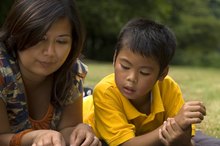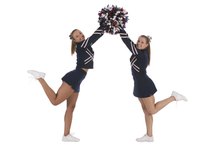What does fact checked mean?
At Healthfully, we strive to deliver objective content that is accurate and up-to-date. Our team periodically reviews articles in order to ensure content quality. The sources cited below consist of evidence from peer-reviewed journals, prominent medical organizations, academic associations, and government data.
- National Institutes of Health: Rythym and Time in the Perception of Down's Syndrome children
- National Institutes of Health: Rythym and Time in the Perception of Down's Syndrome children
The information contained on this site is for informational purposes only, and should not be used as a substitute for the advice of a professional health care provider. Please check with the appropriate physician regarding health questions and concerns. Although we strive to deliver accurate and up-to-date information, no guarantee to that effect is made.
Activities Using Music With Down's Syndrome Children
Down syndrome is a genetic disorder commonly resulting in slower learning, impulsive behavior and short attention span. Musical activities can be beneficial to students with Down syndrome because these students learn best with lessons that are repetitive and engaging. Music is fun for most people and will help a child to pay attention because it is like a game. The rhythms and repetitiveness of music will help a student with Down syndrome remember something more easily than simply telling him. Speech-language pathologist Rachel Arntson says that music stimulates the whole brain, making it an excellent learning tool for children with Down syndrome.
Mirror Songs
Children with Down syndrome often stick out their tongue when talking, due to lack of muscle control. Sit with the student in front of a mirror and play a fun song that the student likes. Sing with the student while you are both looking at the mirror. The student will see her own tongue and can try to model how you use your tongue when you sing.
- Children with Down syndrome often stick out their tongue when talking, due to lack of muscle control.
- The student will see her own tongue and can try to model how you use your tongue when you sing.
Memory
Visual Perception Problems in Children
Learn More
Some of the first things all children learn in their preschool years are the alphabet, how to count, their address and phone number. One of the easiest ways for young children, and children with Down syndrome of all ages, to remember these sequences of information is to put it to a song. You can use pre-made songs for the alphabet or counting, or you can make up a simple, catchy tune. You can make this work for any age or developmental level of the student and for any piece of information or simple directions that needs to be remembered. An additional bonus is that most children with Down syndrome find music motivating, according to Metro Music Therapy Inc., so students will pay more attention and be excited to repeat their songs and will therefore learn the information easily in many cases.
- Some of the first things all children learn in their preschool years are the alphabet, how to count, their address and phone number.
- An additional bonus is that most children with Down syndrome find music motivating, according to Metro Music Therapy Inc., so students will pay more attention and be excited to repeat their songs and will therefore learn the information easily in many cases.
Music Movement
Incorporate music with movement to encourage motor, hand eye-coordination and cognitive skills. Children with Down syndrome are at a high risk of obesity, according to Kennedy Krieger Institute, and are generally much more interested in music than movement 1. Incorporating the two is a great way to get a student with Down syndrome moving. Simple activities can include dancing to a song or having a ball catch to music. Cognitive skills can be increased by tossing a ball to music. Stop the music periodically. Each time the music is stopped, the student must practice a skill that is currently being worked on. For example, if you are working on rhyming with the student, each time the music is stopped the student can say a word that rhymes with “cat”.
- Incorporate music with movement to encourage motor, hand eye-coordination and cognitive skills.
- Cognitive skills can be increased by tossing a ball to music.
Related Articles
References
- Kennedy Krieger: Weight and Down Syndrome
- National Institutes of Health: Rythym and Time in the Perception of Down's Syndrome children
- Metro Music Therapy, Inc: Reaching Beyond Traditional Therapies
- Centers for Disease Control and Prevention. Facts about Down Syndrome
- Down Syndrome Education International. About us
- Children's Hospital of Philadelphia. ‘Self-Talk’ in Adults with Down Syndrome
- Centers for Disease Control and Prevention. Data and Statistics on Down Syndrome
- U.S. Department of Health and Humans Services. National Institutes of Health. What conditions or disorders are commonly associated with Down syndrome?
- American Academy of Orthopaedic Surgeons. OrthoInfo. Down Syndrome: Musculoskeletal Effects
- National Down Syndrome Society. Gastrointestinal Tract & Down Syndrome
- American Cancer Society. Risk Factors for Childhood Leukemia
- American Academy of Orthopaedic Surgeons. Down Syndrome: Musculoskeletal Effects. Jan 31, 2017.
- Centers for Disease Control and Prevention (CDC). Down Syndrome: Data and Statistics. Updated June 27, 2017.
- Centers for Disease Control and Prevention (CDC). Facts About Atrioventricular Septal Defect (AVSD). Sept 26, 2016.
- Holmes, G. Gastrointestinal Disorders in Down Syndrome. Gastroenterol Hepatol Bed Bench. Winter, 2014; 7910: 6-8.
- Mayo Clinic Staff. Down Syndrome. Mayo Clinic. June 27, 2017.
- National Down Syndrome Society. Obstructive Sleep Apnea & Down Syndrome.
- National Institutes of Health. What Conditions or Disorders Are Commonly Associated with Down Syndrome?
Writer Bio
Maggie Lynn has been writing about education, parenting and health topics since 2005, in addition to being an educator. She holds a Master of Science in child and family studies.









